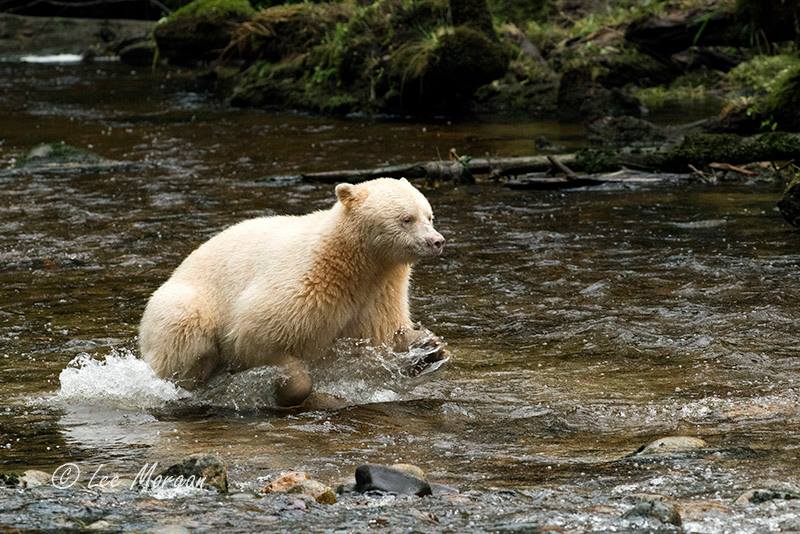Val Perrin travelled on our 'Spirit Bears, Grizzlies & Humpbacks - Cruising the Great Bear Rainforest' holiday and submitted this entry to our writing competition.
Spirit Bear by Lee Morgan
Situated to the north of Vancouver Island, the Great Bear Rainforest covers countless thousands of square miles of uninhabited Pacific British Columbia. This wilderness is a land of mountains clothed in old growth forest, from their misty tops down to the rocky-edged waterline – Sitka Spruce, Western Hemlock, cedar and Red Alder dripping with lichens and beards of trailing moss and ferns. This forms a virtually impenetrable habitat to man, but is home to Wolves, bears, eagles, ravens and a vibrant natural community of other forest creatures. On overcast days the saw-tooth edged headlands of trees march away into the distance, overlapping each other in diminishing grey tones, until dissolved in descending low cloud. Vast channels of the sea penetrate deep inland between these green mountains, the whole area being accessible only by boat or seaplane.
On days of sparkling sunshine we encounter scattering small flocks of pied-plumaged Common Murres and Red-necked Phalaropes, or skeins of harlequin-headed Surf Scoters journeying to the open sea. Anchoring in remote coves we leave our boat, the Island Roamer, in Zodiacs, to explore the wildlife of the furthest recesses of the sea. Ashore, where the tumbling rivers issue forth, is the spectacle of the annual salmon run which drives this whole ecosystem. The shallow waters teem with shoals of the huge fish, wriggling their bodies in the ‘redds’ of gravel where spawning takes place. Only death follows for these magnificent creatures after they’ve passed on their genes to the next generation. Masses of pale fish corpses litter the water and banks, slowly dissolving into the landscape, fuelling it with nutrients, their flesh recycled widely by the bears, gulls and eagles that feast on them.
The special experiences offered by this unique land stir the spirit and move the mind. To be present and to observe the whole swirl of wildlife at these junctions of river and sea beneath the myriad greens of the forest trees is a humbling experience. On one occasion our group stood appreciatively in the soft Pacific rain to witness families of chocolate-furred Grizzly Bears feasting on the salmon, aware but unconcerned by our presence. Clouds of hovering Bonaparte’s, California and other gulls wheeled over the river, grabbing scraps from the bears’ feasts in the water, while overhead up to 10 Bald Eagles, adults and juveniles, circled in the misty sky, awaiting their turn to descend.
On another day, ashore on Gribbell Island, we walked a narrow old former logging trail to a wooden stand built out over the river bank to observe a very rare and special animal, enshrined in First Nations people’s hearts and folklore – the Spirit Bear. Sitting quietly here we were thrilled over the course of the day to see two individuals of these white, honey-tinged hunters patrolling the river very close to us, strolling casually along the fallen logs in the shallow stream, their eyes trained on the spawning salmon, occasionally plunging and catching a writhing sleek fish in their claws and sharp-toothed jaws. Calmly retiring to the river bank to eat their catch among the bushes, they only momentarily glanced in our direction, content to accept us as part of the scene. This was a special privilege for all of us, just for a few hours, to absorb something of the bear’s world, and we trooped back to our boat truly elated to have been so lucky. Spirit Bears are in fact Black Bears, their coat colour the result of a recessive gene. Here on this island they form as much as a quarter of the total bear population of about 40 animals. A day later, on an early morning Zodiac trip on the black mirror-calm water of Cameron Cove, we listened in complete silence to the chittering calls of Bald Eagles, the harsh varied croaking of ravens and the distant, eerie, bone-chilling howls of distant Wolves echoing in the mountains.
So many other wonderful encounters with wildlife and the landscapes were our good fortune on this trip. We viewed ancient red pictographs adorning the sheer rock walls in isolated places, and were awed by massive waterfalls cascading hundreds of feet down mountainsides, their force swollen by recent rains. Also gazing into the bull kelp-strewn quiet channels packed with undersea life was an extra revelation – Moon and Lion’s Mane jellyfish, huge softly spined orange sea cucumbers and ghostly ectoplasms of nudibranchs floating in the current heightened our appreciation and understanding of these ecosystems – informed by our enthusiastic and knowledgeable naturalist guides Lee and his wife Lindsay.
The cetacean-life was spectacular too: numerous fluking Humpback Whales throughout our voyage, plus occasional Fin Whales and Dall’s Porpoises added to the mix. The highlight had to be the occasion when we were tracking slowly in Ocean Roamer alongside a Humpback Whale repeatedly breaching right beside us, its huge glistening black 40-tonne frame laced with water before it plunged back in exploding banks of white foam. And just within the last 20 minutes of the voyage we travelled amidst a pod of 7 Orcas, their various-shaped dorsal fins slicing the choppy waters of Milbanke Sound. Pure magic – we couldn’t have wished for better.
Read more about our 'Spirit Bears, Grizzlies & Humpbacks - Cruising the Great Bear Rainforest' holiday.



 Loading search...
Loading search...
